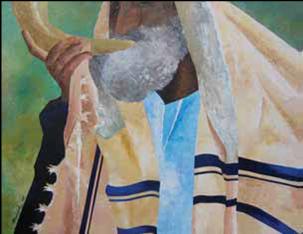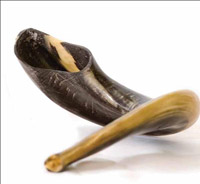
Rosh Hashanah
하나님의 백성을 부르는 나팔소리 -올리비에 멜릭 로쉬 하샤나에는 빵 부스러기를 물 위에 던지고, 숫양의 뿔로 나팔을 불며, 하나님의 거룩함에 대한 응답으로 회개의 기도를 드린다.
전통 규례의 유래. 로쉬하샤나의 전통은 ‘레위기’에서 기원하다. 하나님께서는 그의 무한한 지혜와 사랑으로, 그 선택한 백성에게 ‘정한 때’ 또는 ‘거룩한 회합(성회)’을 알리는 달력을 제공한다.(레23:1-2). 로쉬하샤나는 그 중의 하나이다. 놀랍게도 하나님께서 정하신 이 거룩한 날들은 몇 천 년이 지났음에도 불구하고 오늘날까지 유대 백성에게 그 정체성을 제공하고 있다.
성경적 관점. 로쉬하사나는 성경적으로는 유대 백성에게, 예언적으로는 온 인류에게 위대한 시즌의 시작이다. 이는 또한 구약성경의 여러 곳에서 언급되고 있다.(민29:1-6, 시81:3-4, 느8:1-2) 레위기 23:23-25에서 유대 백성은 거룩한 회합(성회)의 의미로 티쉬레이 달 첫째 날에 쇼파르 나팔을 불도록 지시받고 있다. 그 날은 어떤 일도 해서는 안되며, 오직 주께 번제를 올려야 한다. 성경에 의하면 이 나팔절은 3개의 가을 절기의 첫 번째로서 그 주제는 회개이며 이어지는 두 절기(대속죄일, 장막절)에 대한 준비를 하는 것이다.
랍비적 전통들 로쉬하샤나의 의미는 ‘1년의 머리’라는 뜻이다. 이 거룩한 날은 유대력의 시작이며, 티쉬레이 달(성경력의 일곱번째 달)에 지켜진다. 풍습의 주요한 명령은 쇼파르를 부는 것이나 그 이유는 성경에서 나타나지 않는다. 결과적으로 랍비들이 언제 어떻게 쇼파르를 불어야 하는지에 대한 많은 설명들을 하고 있다. 랍비들은 마지막에 테키아 게돌라(위대한 나팔- 부는 자가 숨이 있는 한 계속 불어야 함)를 불기까지 100번의 쇼파르가 불려져야 한다고 믿고 있다. 오늘날 어떤 이들은 이 마지막 나팔이 이스라엘의 국가적 회복에 대한 희망을 상징한다고 믿는다. 로쉬하샤나의 첫째 날, 전 세계에 있는 유대 민족은 그들의 주머니에 있는 빵 부스러기를 비워 물그릇에 던진다. ‘앞으로 던지다’라는 의미의 이 타쉴리히 전통은 하나님께서 이스라엘의 죄를 바다로 던져버린다는 미가서 7:18-20절에 근거를 둔다. 이 날은 또한 대속죄일인 욤키푸르를 준비하는 기도와 회개의 시간인 ‘10일의 경외(Ten days of awe)’기간의 시작이다
하나님의 위대한 계획 많은 믿는 유대인들은 이 각각의 레위기의 성회가 이미 성취되었으며 또 하나님의 회복의 시간에 맞춰 어떤 특정한 사건에 의해 성취될 것이라는 점에 동의한다. 봄의 절기들이 메시아의 초림에 의해 성취되었듯이, 가을의 절기들은 그분의 재림에 의해 성취될 것이라고 믿는다.

| 성경의 거룩한 날들 | 성취 | 메시아의 초림 | 유월절 | 메시아의 죽음 | 초실절 | 메시아의 부활 | 오순절 | 메시아의 몸의 탄생 | 메시아의 재림 | 로쉬하샤나/나팔절 (신년) | 마지막 때임을 알리는 나팔소리 | 욤키푸르 (대속죄일) | 대환란 | 수콧 (장막절) | 메시아의 천년 왕국 |
가을 절기들은 하나님께서 그의 백성 유대 민족을 잊지 않으셨고, 그 민족 또한 하나님을 잊지 않았음을 온 세상에 기억하게 한다. 전 세계에 있는 유대 민족이 쇼파르를 불 준비를 하고 기도하듯이, 메시아는 그의 백성이 그를 알고 그를 신뢰하기를 고대한다.
| 로쉬하샤나 (나팔절) | 욤키프르 (속죄일) | 수콧 (장막절; 수장절; 기쁨의 절기) | 유대 규례 | 쇼파르(숫양의 뿔)를 붐
전통적인 인사법 –l’shanah tovah tikatevu (좋은 한 해가 되도록 새김)
절기음식 – 왕관 모양의 할라빵 (왕이신 주님을 강조)
꿀을 바른 사과 (올해도 달콤한 한 해가 되길 비는 마음)
티쉬리히 의식 – 빵 부스러기를 물에 던짐 (우리의 ‘죄를 던져 버림’을 상징)
특별 회당 예배 – 용서와 회개, 하나님과 그의 이스라엘과의 언약을 강조 | 금식: 물과 음식을 모두 먹지 않음
일하지 않음
엄숙한 자기 반성과 겸허의 날 (회개와 기도를 강조)
카파롯 – 닭을 바치는 의식이 행해졌지만 현재는 거의 보이지 않음. 이 의식은 성전이 무너지면서 불가능 해진 대제사장의 희생제물을 바치는 것을 기억하기 위한 것임
하얀 옷을 입음. 이는 겸허와 죄를 용서하시는 하나님의 능력에 대한 신념을 상징함
장시간의 회당 예배는 하나님의 거룩함과 그분의 눈앞에서 실패하는 우리의 모습을 보여줌 | 가족들이 큰 가지와 나뭇잎으로 덮인 잔가지로 엮어 만든 임시 거처인 장막/초막에서 거함. 이는 출애굽 이후의 광야 생활 동안의 하나님의 보호하심을 기억하기 위함임.
아르밧 하미님 : 에트로그 (이스라엘에서 자생하는 감귤류의 열매), 룰라브 (종려나무 가지), 하다스(머틀 가지), 아라바(버드나무 가지)의 4가지 종류로 경배와 장막 축복에 사용 – 에트로그는 왼손에, 나머지는 오른손에 들고 장막 안에서 낭독과 함께 동서남북, 상하로 흔들면서 모든 곳에 임재하시는 하나님을 상징함. 레위기 23:40절에서 근거
우쉬피진(‘손님’이라는 아람어) – 환대는 장막절의 전통으로 사람들이 서로의 장막을 방문하여 함께 음식을 먹음 | 구약 말씀 | 레위기 23:23-25, 민수기 29:1-6 | 레위기 16, 23:26-32, 민수기 29:7-11 | 레위기 23:33-36, 39-43, 민수기 29:12-34, 신명기 16:13-15, 에스라 3:1-4, 느헤미야 8:14-15 | 신약 말씀 | 명확하게 언급되고 있지는 않지만, 쇼파르 나팔소리와 전능하신 하나님의 심판과 회복과은 연결은 마태복음 24:29~31, 데살로니가 전서 4:16~17, 요한계시록 11:15~18절에 나타남 | 히브리서 9:7, 10:1-3, 19-22 | 요한복음 7장, 8장은 장막절에 일아나는 사건임 | 메시아 적용 | 예수님(예수아)은 용서와 하나님의 약속이 현재, 그리고 미래에도 신실하게 지켜질 것이라는 우리의 소망을 구체화하는 분으로 하나님께서 주시고 실행하신 권위로 우리의 ‘왕’이 되십니다. (마태복음 11:27, 요한복음 16:15). | 예수님은 대제사장입니다. 속죄제물로서 그의 보혈은 우리의 죄를 깨끗하게 하십니다 (로마서 3:24-26). 대제사장으로써 예수님은 죄가 없이 속죄제를 드리는 자격을 가지면서, 동시에 그 자신이 한번에 그리고 모두를 위한 완전한 속죄제물이 되셨습니다. | 장막절에 모두 함께 모이는 것은 메시아 왕국에 대한 약속을 반드시 성취하실 것이라는 것을 강조합니다. (스가랴 14:16-19). 하나님께서 장막에서 거하실 것이라는 것이 계시록 21:3 에서 가장 잘 나타납니다. “…보라 하나님의 장막이 사람들과 함께 있으매 하나님이 저희와 함께 거하시리니…” |
출처: Volume XIV, Issue 7 September 2008. www.chosenpeople.com
Rosh Hashanah
A Trumpet Call for God’s People By Olivier Melnick Olivier Melnick and his wife Ellen serve with Chosen People in Orange County, California. Bread crumbs floating on water, rams’ horns used as trumpets, and prayers of repentance represent responses to God’s holiness on Rosh Hashanah.
Origin of the Observance. The observance of RoshHashanah originated in the Book of Leviticus. In His infinite wisdom and love, God provided His chosen people with a calendar of “appointed times” or “holy convocations” (Lev. 23:1-2) of which Rosh Hashanah is one. Amazingly, these God-ordained Holy Days still provide identity to the Jewish people today despite the passage of several millennia.
Biblical Perspective. RoshHashanah begins a great season both biblically for the Jewish people and prophetically for all mankind. It is also mentioned elsewhere in the Hebrew Scripture (Num. 29:1-6, Ps. 81:3-4, Ezra 3:1-6, Neh. 8:1-12). In Leviticus 23:23-25, the Jewish people were instructed to blow the shofar (ram’s horn) on the first day of the month of Tishrei, as a holy convocation. They were to do no laborious work, but present an offering by fire to the Lord. According to Scripture, the Feast of Trumpets is the first of three Fall Feasts. The theme of Rosh Hashanah is repentance in preparation for the other two feasts: Yom Kippur (the Day of Atonement) and Sukkot (the Feast of Tabernacles).
Rabbinic Traditions. The traditional name Rosh Hashanah means “head of the year.” This holy day begins the Jewish civil calendar year and is observed in Tishrei, the seventh month of the biblical Jewish calendar. The main command for observance is to blow the shofar, but no reason is given in the Bible. As a result, rabbis have come up with many explanations as to how and when the shofar should be blown. The rabbis believed that there were to be one hundred blasts of the shofar culminating in the final Tekiah Gedolah, meaning “the great blast,” to be held for as long as the blower had breath. Today, some believe this last trumpet blast symbolizes the hope of Israel’s national redemption. On the first day of Rosh Hashanah, Jewish people around the world empty bread crumbs from their pockets into a body of water. Known as Tashlich, meaning “the casting forth,” the tradition is based on Micah 7:18-20, a prophecy that God would cast Israel’s sins into the sea. This also marks the start of the “Ten Days of Awe,” a time of prayer and penitence in reparation for Yom Kippur, the Day of Atonement.
God’s Grand Plan Revealed. Many Messianic believers agree that each of the Levitical holy convocations has been or will be fulfilled by a specific event in the timeline of God’s redemption. As the Spring Festivals were all fulfilled by the First Coming of the Messiah, we believe the Fall Festivals will be fulfilled by His Second Coming. Biblical Holy Day | Fulfillment | Messiah’s First Coming | Passover (Pesach) | Messiah’s sacrificial death | First Fruits | Messiah’s victorious resurrection | Shavuot (Feast of Weeks) | Birth of the Body of Messiah | Messiah’s Second Coming | Rosh Hashanah (New Year) | Trumpet Blast heralding End Times | Yom Kippur (The Day of Atonement) | The Great Tribulation | Sukkot (Feast of Tabernacles) | The thousand-year Messianic Kingdom |
liThe Fall Feasts remind the world that God has not forgotten His Jewish people and they have not forgotten Him. As Jewish people around the world prepare to blow shofars and pray, Messiah longs for His people to know and put their trust in Him. (Yom Kippur and Sukkot also fall in the month of Tishrei. You can find articles on these feasts at www.chosenpeople.com.)
| Rosh Hashanah (Feast of Trumpets) | Yom Kippur (Day of Atonement) | Sukkot (Feast of Tabernacles; Feast of Ingathering; Season of our Rejoicing) |
Jewish Observances: | Blowing of the shofar (ram’s horn)
Traditional greeting—l’shanah tovah tikatevu (may you be inscribed for a good year)
Special holiday meal featuring a loaf of hallah (Sabbath egg bread) baked into the shape of a crown, emphasizing the Lord’s kingship
Eating of apples and honey to symbolize the hope of a “sweet” year to come
Tashlich ceremony—casting bread crumbs into flowing water to symbolize the “casting off“ of Sins
Special synagogue services that stress our need for forgiveness, repentance, the sovereignty of God and His covenant promises to Israel | Fasting from both food and water
No work done
A solemn day of introspection and humility emphasizing repentance, prayer and works of mercy
Kapparot—now seldom-seen ritual sacrifice of a chicken, in memory of the High Priest’s sacrifice which is no longer possible because of the destruction of the Temple
The wearing of white garments, symbolizing humility and confidence in God’s power to forgive sins
Lengthy synagogue services that dwell upon God’s holiness and our failings in His sight | Families live in booths—temporary shelters constructed of boughs and leafy branches—to remind us of God’s protection during the wilderness wandering after the Exodus. Arbat HaMinim (the Four Species): the Etrog (citron, a citrus fruit native to Israel), Lulav (palm branch), Hadas (myrtle branch) and Arava (willowbranch) are used in worship and to bless the booth. With the citron in the left hand, and the others held together in the right, a blessing is recited inside the sukkah (booth) and the items are waved east, south, west, north, up and down as a symbol that God’s presence is everywhere. This practice is based on Leviticus 23:40.
Ushpizin (Aramaic for “guests”)— Hospitality is a Sukkot tradition, with people visiting each other in the sukkah and eating together. | Hebrew Scripture: | Leviticus 23:23-25, Numbers 29:1-6 | Leviticus 16, 23:26-32, Numbers 29:7-11 | Leviticus 23:33-36, 39-43, Numbers 29:12-34, Deuteronomy 16:13-15, Ezra 3:1-4, Nehemiah 8:14-15 | New Testament: | Not explicitly mentioned—but the connection of the sound of the shofar to God’s mighty work of judgment and restoration may be found in Matthew 24:29-31, 1 Thessalonians 4:16-17 and Revelation 11:15-18 | Hebrews 9:7, 10:1-3, 19-22 | John 7 and 8 take place on Sukkot. | Messianic Application: | Yeshua (Jesus) embodies our hope of forgiveness and God’s promise to be faithful to us now and in the future. He is the King through whom the authority of the Father is given and exercised (Matthew 11:27, John 16:15). | Jesus is our High Priest. He is the One through whom our redemption is bought through the shedding of His blood as an atoning sacrifice (Romans 3:24-26). As High Priest, Jesus is not only qualified to bring the unblemished sin offering, but is Himself the perfect offering for atonement, once and for all. | Sukkot’s emphasis on ingathering is unmistakably bound to the fulfillment of Messiah’s Kingdom promises (Zechariah 14:16-19). Moreover, the theme of God’s sheltering tabernacle is most fully expressed in Revelation 21:3: “…Behold, the tabernacle of God is with men and He will dwell with them…”
|
|